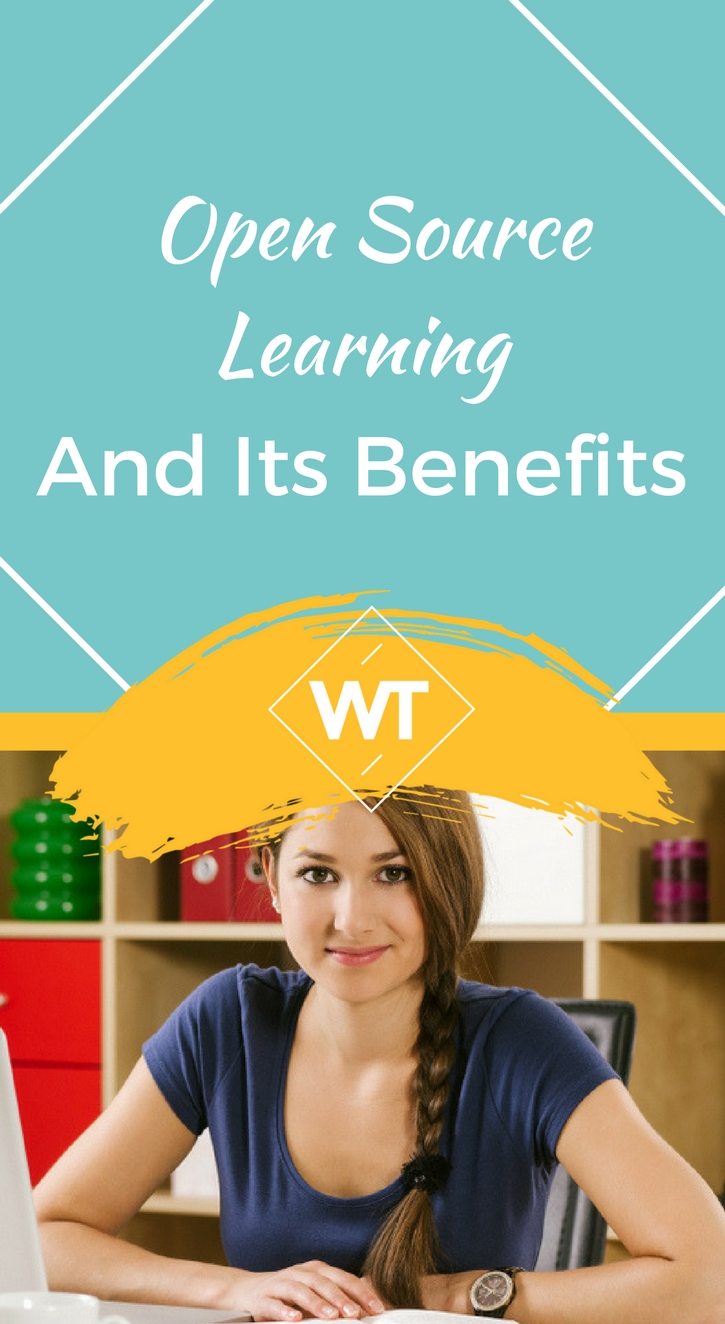Open Source Learning and its Benefits

The concept of ‘open source learning’ started in the software development field where open source was a movement where software is open to everyone to use, modify or customize according to their requirements. Examples of open source software include Mozilla Firefox, Android and other software which are free to use.
On the other hand licensed software such as Microsoft Office, Windows, etc are proprietary and their use is licensed or allowed to users who have purchased the rights after paying the license fee. In simple terms open source tools are free to use while all other software tools are commercial and proprietary in nature.
Open source in Education
The open source movement also enabled programmers, users and other users to learn and get trained on the software and also explore new codes, innovations, etc which can help future development.
As this movement gathered pace it also moved to websites, blogs, knowledge resources, etc. For example Wikipedia.org allows a collaborative framework for building a large encyclopedia of knowledge where anyone can add, modify and contribute content.
In the past few years Open Source Learning is catching up in a big way. Its not about distance learning or online courses which are commercial in nature.
Open source learning is about providing free access to education online for anyone who is keen to learn. Unlike a university of educational institutions the prerequisites or entry requirements are not so stringent. Moreover, one can learn a subject at their own pace from anywhere, at convenient time schedules.
Examples
Some of the popular open source educational portals I came across were Khan Academy (khanacademy) and Coursera (coursera). However, there are plenty of other sources which I may not be aware of. In addition to this there are websites where discussions and sharing of knowledge can take place. An example of this is OpenStudy (openstudy).
Is Open Source Learning as good as full time education?
Before we go ahead let me provide this disclaimer. Open Source Education is not a replacement for your formal full time education nor can it be equivalent to a professional or university degree.
Open source education should only be used for your own personal knowledge improvement or enrichment.
You should generally consider it as a library or a tutorial to learn, and not as an academic or professional course. However, if you use this medium of open source learning effectively you can reap several benefits.
Benefits
- Accessibility: Being available in online medium it is highly convenient to access from anywhere.
- Convenient Schedule: Since open learning provides content online you can choose a schedule which is convenient for you. This is a boon for full-time professionals and employees who cannot afford to leave work and attend full-time studies.
- Trial: You can use open source as a medium to understand a subject or topic before enrolling for a full time course.
- It can be used as an addition add-on to a full-time degree.
- Assistance: You can get assistance on topics or areas which is not clear from text books or lectures.
- In several cases you get to know how certain concepts are applied and used in the practical world. This is one major advantage of open source learning.
- Unlike in universities, you need not go through elaborate theories or concepts that are irrelevant. In open source world you have to go through a few concepts that are relevant to you saving time and energy.
There are various other benefits or unique features that some portals provide. For instance you can choose select areas/topics rather than starting from ground zero. For example if you want to learn advanced calculus and integration, where you need additional training you can directly jump to that area instead of starting from ground zero.
Lets look at some portals and see what they offer to get a better understanding of their features.
Khan Academy
The Idea: This is a wonder initiative by Salman Khan (also called ‘Sal’), the Founder of the academy who previously worked as an Analyst for a hedge fund. Sal used to teach one his cousins online using tools such as Yahoo Doodle.
There were more friends, close contacts who wanted to avail his tutoring and Sal decided to upload a video on You tube so that his students can access his sessions anywhere and anytime at their convenience. This helped Sal to organize his time and schedule better.
Later, the initiative expanded and the Khan Academy was born with a wide range of topics and a large team to manage the open source learning initiative. From here on there was not turning back as the academy grew rapidly achieved several milestones and awards.
Features
- Videos: This is the most prominent feature, which is similar to YouTube. Although it sounds common the biggest advantage is the ability to start, stop, pause or review anytime. You don’t have to worry about CDs, mpg files, etc., since all content is available online.
- Wide range of subjects and topics: Khan Academy has an offering for people from various disciplines such as maths, science, history, economics, finance, calculus, physics, etc.
- Exam Prep: There are specialized sections on exam tutorials such as SAT and GMAT. A few more exam related content will come in the near future.
- Practice Section: This section which was added after the videos provided a platform for learners to practice tests and assignments. This is one area which is expensive and inaccessible to many students from lower and middle class families who cannot afford test guides, books, etc.
- Coaching: This is another initiative which enables teachers/coaches to access the platform to teach students, track their progress, view class statistics and various other reports and features. Various tools, resources and aids are available for teachers.
- Volunteers: Khan Academy encourages people to volunteer to spread education to all. You can volunteer in several ways such as spreading the word around, teaching/coaching on the website, contribute donations, participate in online community or monitor the community, assist in translating videos/content in to other languages and various other ways. Please visit this section to know more.
Khan Academy is a unique success story because it managed to offer open source content for everyone to access despite being a non-profit organization. In September 2010, Khan Academy received a $2 million grant from Google and a $1.5 billion grant from Bill and Melinda Gates foundation, which helped the academy to expand in to a large organization.
(Source:khanacademy)
Khan Academy is also working on tie-ups and arrangements with universities to provide its valuable platform to university students.
Coursera.org
(Source: coursera)
Coursera is a technology-enabled educational initiative started by Stanford professors. Coursera is committed to making the best education available for anyone who seeks it.
Their business model is not known in public domain, however one of its founders have hinted that there would be valuable premium services offered for a cost.
The main strength of Coursera lies in its partnership with leading universities including Stanford University, University of Michigan, Princeton (University of Pennsylvania). Recently in July 2012 a number of universities have tied up with Coursera.
Features
- Videos: You can get access to videos on different subjects directly from the professors of various educational institutions and universities. There is a slight difference in the organization of videos because you will find distinct courses offered by different universities.
- Organization: As mentioned earlier you have a course outline that tells you exactly what is covered from start to end.
- Schedule/Timings: This is where Coursera differs dramatically from Khan Academy. If you enrol for a course you can learn at your pace, but you have deadlines to meet. For example you may have 10-12 videos and one assignment scheduled every week. One has to be serious and organized here in order to meet the schedule and course requirements.
- Performance: Coursera may provide a ‘Letter of Completion’ once you complete a course, but this is subject to the decision of Coursera.org and instructors. This should be considered as an acknowledgement of participation.
- Reference: This portal provides access to brief notes covering important topics. For instance you may get brief notes of certain concepts, formulas, etc.
- Discussion Forum: This is place where students, professors and other users can discuss on various topics.
For people who believe in endorsement of university, Coursera may appear to have an edge over Khan Academy. However, in both cases the courses are only an add-on or supplement to full-time or professional education.
For busy professionals, open source learning can be a boon to get trained or exposed to new areas or subjects of interest. Similarly for those preparing for exams such as SAT, GMAT, etc. online tutorials, practice tests, mock exams, etc. would be helpful. I would strongly recommend you to visit Khan Academy and watch videos of any topic of interest. However, for Coursera you should check the course schedule and choose a course accordingly.
Whether you find free time in office or at home, it’s a good idea to spend time on improving your knowledge. These are excellent resources for learners as well as trainers or professionals who want to upgrade their knowledge and skills. I have signed up on both websites and have been a regular user, and would recommend you to try and get maximum benefit from them.









Leave a Reply